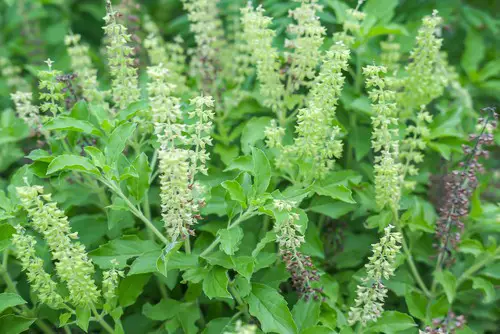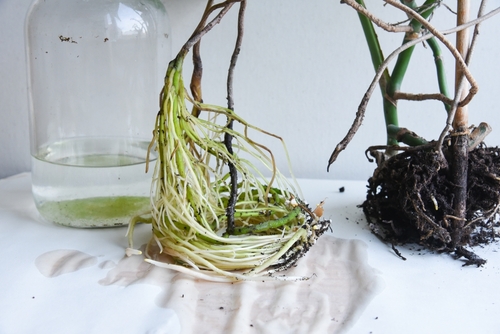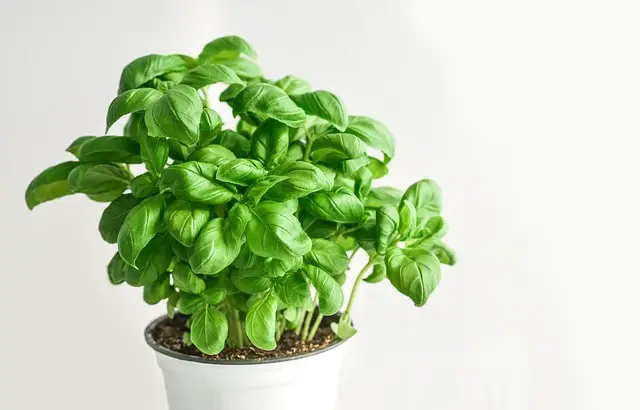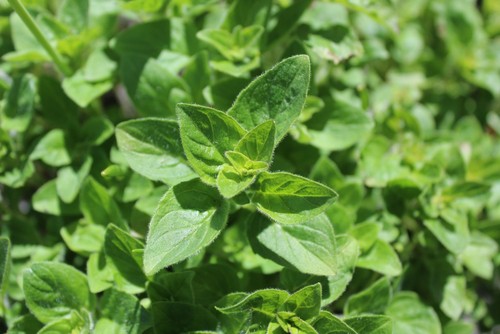Basil is a popular herb that many people grow in their gardens or homes. It is used in a variety of dishes and has many health benefits. However, sometimes basil plants can start to wilt or die, which can be frustrating for those who have put time and effort into growing them.
There are several reasons for a dying basil plant, including overwatering, underwatering, temperature stress, lighting problems, disease, or pests. Understanding the ideal conditions for basil plants and the common problems they face can help prevent a dying basil plant.
Proper watering, lighting, and nutrient needs are crucial for basil plant health. Reviving a dying basil plant may also be possible with proper care and attention.
Key Takeaways
- Understanding the ideal conditions for basil plants and the common problems they face can help prevent a dying basil plant.
- Proper watering, lighting, and nutrient needs are crucial for basil plant health.
- Reviving a dying basil plant may also be possible with proper care and attention.
More posts on this category:
Understanding Basil Plants

Basil is an annual herb that belongs to the mint family. It is a popular herb that is widely used in cooking, especially in Italian and Thai cuisine. Basil plants are easy to grow, and they can be grown both indoors and outdoors.
Basil plants have a typical life cycle of one year, and they grow best in warm and sunny conditions. They can grow up to two feet tall and have green leaves that are fragrant and flavorful. Basil plants come in different varieties, such as sweet basil, lemon basil, and Thai basil, among others.
Basil plants are sensitive to cold temperatures, and they do not tolerate frost well. They also require well-draining soil and adequate moisture to thrive. Overwatering or underwatering can cause the basil plant to wilt or die. Basil plants also require regular pruning to encourage bushy growth and prevent flowering, which can make the leaves bitter.
In terms of care, basil plants are relatively low maintenance. They require regular watering, fertilization, and pruning to maintain their health and vigor. Basil plants can be propagated from seeds or cuttings, and they can be grown in pots or in the ground.
Ideal Conditions for Basil
Basil is a heat-loving plant that requires specific growing conditions to thrive. The following are the ideal conditions for growing basil:
1. Light
Basil requires bright, indirect light to grow. It needs an average of 6 to 8 hours of direct sunlight per day to thrive. It may succumb to temperature shock at anything below 50 degrees Fahrenheit (10 degrees Celsius).
2. Water
Basil needs lots of water, make sure to always keep the soil moist. Overwatering or underwatering can cause the plant to wilt or droop. It is important to water the plant frequently, especially in hot weather.
3. Soil

Basil requires well-draining soil to grow properly. Planting in a pot without drainage holes, or one where the drainage holes are inadequate, can cause the soil to become waterlogged, leading to root rot and plant death. Using soil that is poorly draining can also cause the plant to die.
4. Temperature
Basil is a plant that really thrives in warm weather. It can’t be grown outside until temperatures rise beyond 55°F (13°C) and grow best in 70°F (21°C). Plants exposed to colder conditions will grow very slowly or die off.
5. Sunlight
Basil requires full sun, but it can also grow in partial shade. If the plant is grown in full sun, it needs to be watered more frequently to avoid drying out.
6. Growing Conditions
Basil grows best in a warm, moist environment with good airflow. The pot should be large enough to accommodate the plant’s roots and allow for proper drainage. The soil should be kept moist but not waterlogged.
7. Frost
Basil is sensitive to frost and should be grown indoors or in a greenhouse during the winter months in colder climates.
Dying Basil Plant – 6 Common Problems
Basil plants are generally easy to grow, but they are susceptible to a variety of problems that can cause them to wilt, turn yellow, and ultimately die. Here are some of the most common problems that basil plants can face:
1. Overwatering and Underwatering
Overwatering and underwatering can both cause problems for basil plants. Overwatering can lead to root rot, which can cause the roots to rot and the plant to wilt. Underwatering, on the other hand, can cause the leaves to dry out and the plant to wilt.
2. Diseases and Pests

Basil plants can be susceptible to a variety of diseases and pests, including fusarium wilt, bacterial leaf spot, downy mildew, and whiteflies. These problems can cause the leaves to turn yellow, brown, or black, and can ultimately lead to the death of the plant.
3. Insufficient Light
Basil plants need plenty of sunlight to thrive. If they don’t get enough light, they can become leggy and weak, and may ultimately die. If you’re growing basil indoors, make sure it’s getting at least six hours of sunlight per day.
4. Fertilizer Issues
Over-fertilizing can cause the leaves of a basil plant to turn yellow or brown, while under-fertilizing can cause the plant to become stunted and weak. Make sure you’re using the right type and amount of fertilizer for your basil plant.
5. Pruning and Harvesting
Pruning and harvesting can help keep your basil plant healthy and productive, but if you do it too much or at the wrong time, it can cause the plant to become stressed and ultimately die. Make sure you’re pruning and harvesting your basil plant correctly.
6. Temperature and Humidity
Basil plants prefer warm temperatures and high humidity. If the temperature drops too low or the air becomes too dry, the plant may wilt and die. Make sure you’re growing your basil plant in a warm, humid environment.
The Importance of Proper Watering
Basil plants require consistent moisture to thrive, but overwatering or underwatering can lead to the plant’s demise. When watering basil, it is essential to find the right balance between keeping the soil moist and not allowing it to become waterlogged.
Overwatering basil plants can lead to root rot, which is often fatal. When soil is too moist, the roots cannot access the oxygen they need to survive. This can cause the roots to stop functioning, leading to the plant’s death. Signs of overwatering include yellowing leaves, wilting, and a musty odor coming from the soil.
On the other hand, underwatering basil can cause the plant to wilt and eventually die. When the soil is too dry, the roots cannot absorb water and nutrients, leading to dehydration. Signs of underwatering include drooping leaves, dry soil, and brittle stems.
To properly water a basil plant, it is best to keep the soil consistently moist. This means watering the plant frequently but not allowing the soil to become waterlogged. A good soak once a week is usually sufficient, but in hot weather, the plant may require more frequent watering.
When watering basil, it is essential to avoid getting water on the leaves, as this can cause fungal diseases to develop. Instead, water the soil around the plant’s base, allowing the water to soak in slowly.
The Role of Light in Basil Plant Health

Light is a critical factor in the health of basil plants. Basil plants require consistent light to grow and be healthy. Insufficient light can cause the plant to become weak and spindly, with small leaves and a lack of flavor.
Basil plants thrive in full sun, but they can also grow well in indirect light. If growing indoors, it is essential to ensure that the plant is exposed to enough sunlight. Placing the plant next to a window that gets a lot of light is an excellent option for indoor growing.
Direct sunlight is essential for basil plants to grow well. If growing outdoors, it is best to place the plant in a location that receives at least six hours of direct sunlight daily. However, excessive exposure to direct sunlight can cause the plant to wilt and dry out.
If growing basil indoors, it may be necessary to use grow lights to provide sufficient light. Grow lights can be an excellent option for those who do not have access to enough natural light. When using grow lights, it is essential to ensure that they are placed at the correct distance from the plant to avoid causing damage.
Nutrient Needs for Basil
Basil plants require a variety of nutrients to grow healthy and strong. Proper nutrition is essential for the plant’s growth and development, as well as for its resistance to disease and pests. Here are some of the essential nutrients that basil plants need:
1. Roots and Soil
Basil plants need well-draining soil to prevent waterlogging and root rot. The soil should be rich in organic matter and have a pH between 6.0 and 7.5. The plant’s roots need oxygen to function properly, so compacted soil or soil that is too heavy can impede root growth.
2. Nutrients
Basil plants need a balanced supply of macronutrients and micronutrients to grow healthy and strong. Macronutrients, such as nitrogen, phosphorus, and potassium, are required in larger amounts, while micronutrients, such as iron, manganese, and zinc, are needed in smaller amounts.
A lack of nutrients can cause stunted growth, yellowing leaves, and poor flavor.
3. pH
The pH level of the soil can affect the availability of nutrients to the plant. Basil plants prefer a slightly acidic soil with a pH between 6.0 and 7.5. If the soil is too alkaline, the plant may have difficulty absorbing certain nutrients, such as iron and manganese.
4. Fertilizer

Fertilizer can help replenish the nutrients in the soil and promote healthy growth. Basil plants benefit from a balanced fertilizer with equal amounts of nitrogen, phosphorus, and potassium. Over-fertilization can lead to excessive growth and poor flavor, while under-fertilization can cause stunted growth and yellowing leaves.
Basil Plant Diseases and Pests
Basil plants are susceptible to a range of diseases and pests that can cause the plant to wilt or die. In this section, we will discuss some of the most common basil plant diseases and pests and how to treat them.
Diseases
Basil plants are prone to several diseases that can cause discoloration, wilting, and death. Some of the most common basil plant diseases include:
- Fusarium wilt: A fungal disease that causes yellowing and wilting of the leaves. The fungus can survive in the soil for years, making it difficult to control. Infected plants should be removed and destroyed to prevent the spread of the disease.
- Bacterial leaf spot: A bacterial disease that causes brown spots on the leaves, which can lead to defoliation and plant death. Infected plants should be removed and destroyed to prevent the spread of the disease.
- Gray mold: A fungal disease that causes grayish-brown spots on the leaves and stems. The disease can spread rapidly in humid conditions and can cause plant death. Infected plants should be removed and destroyed to prevent the spread of the disease.
Pests
Basil plants are also susceptible to a range of pests that can cause damage to the leaves and stems. Some of the most common basil plant pests include:
- Aphids: Small, soft-bodied insects that suck the sap from the leaves and stems of the plant. They can cause stunted growth and yellowing of the leaves. Aphids can be controlled with insecticidal soap or neem oil.
- Whiteflies: Tiny, white insects that suck the sap from the leaves. They can cause yellowing and wilting of the leaves and can transmit viruses to the plant. Whiteflies can be controlled with insecticidal soap or neem oil.
- Nematodes: Small, worm-like creatures that live in the soil and feed on the roots of the plant. They can cause stunted growth and yellowing of the leaves. Nematodes can be controlled by rotating crops and using nematode-resistant varieties of basil.
Root Rot

Root rot is a common problem in basil plants that can be caused by overwatering or poor drainage. The roots of the plant become waterlogged and begin to rot, which can cause the plant to wilt and die. To prevent root rot, make sure the soil is well-drained and allow the soil to dry out slightly between watering.
Mildew
Basil plants are also susceptible to mildew, which is a fungal disease that causes a white or grayish coating on the leaves. Mildew can be caused by high humidity or poor air circulation.
To prevent mildew, make sure the plant has good air circulation and avoid overhead watering. Infected leaves should be removed and destroyed to prevent the spread of the disease.
Reviving a Dying Basil Plant
When a basil plant starts to wilt, it may seem like all hope is lost. However, with the right care and attention, it is possible to revive a dying basil plant and bring it back to life. Here are some tips and tricks to help you revive your basil plant:
1. Watering
The most common reason for a basil plant dying is due to improper watering. Overwatering or underwatering can both lead to the plant’s death. To revive a dying basil plant, it is important to water it properly.
- Make sure the soil is moist but not waterlogged.
- Water the plant deeply, allowing the water to soak into the soil.
- Allow the soil to dry out slightly before watering again.
2. Sunlight
Basil plants need sunlight to grow, but too much direct sunlight can be harmful and cause the plant to wilt. To revive a dying basil plant, it is important to provide it with the right amount of sunlight.
- Place the plant in an area that receives morning sun and afternoon shade.
- If the plant is indoors, place it near a window that receives bright, indirect sunlight.
3. Soil
The type of soil used to grow basil plants can also impact their survival. Using poor quality soil or soil that is too dense can cause the plant to wilt and die.
- Use well-draining soil that allows water to flow freely through it.
- Add organic matter to the soil to improve its quality and texture.
4. Pruning
If a basil plant is dying, it may be necessary to prune it to help it recover. Pruning can help to remove any dead or damaged leaves and encourage new growth.
- Use clean, sharp scissors or pruning shears to remove any dead or damaged leaves.
- Cut back the plant to encourage new growth and prevent it from becoming too leggy.
5. Pests and Diseases
Pests and diseases can also contribute to a basil plant’s decline. To revive a dying basil plant, it is important to identify and treat any pests or diseases that may be affecting it.
- Check the plant for signs of pests such as aphids, spider mites, or whiteflies.
- Treat the plant with an appropriate insecticide or fungicide to eliminate pests or diseases.
Pruning and Caring for Basil

Basil is a popular herb that is easy to grow and care for. However, it is not uncommon for basil plants to start dying due to various reasons, such as overwatering, underwatering, pests, and diseases. Pruning and caring for basil can help keep the plant healthy and productive.
Pruning Basil
Pruning is an essential part of caring for basil. It helps the plant grow bushier, produce more leaves, and prevent it from flowering and going to seed too quickly. Here are some tips for pruning basil:
- Pinch off the top two sets of leaves when the plant reaches about six inches tall. This will encourage the plant to branch out and grow more leaves.
- Pinch off any flowers that appear on the plant. This will prevent the plant from going to seed too quickly and ensure that it continues to produce leaves.
- Pinch off any yellow or damaged leaves. This will help the plant focus its energy on producing healthy leaves.
- Prune the plant regularly throughout the growing season to encourage more branching and leaves.
Caring for Basil
In addition to pruning, caring for basil involves providing it with the right growing conditions. Here are some tips for caring for basil:
- Water the plant regularly, but be careful not to overwater it. Basil prefers moist, well-drained soil.
- Provide the plant with at least six hours of sunlight per day. If the plant is in a hot, sunny location, it may benefit from some afternoon shade.
- Fertilize the plant every two to three weeks with a balanced fertilizer. This will help ensure that the plant has the nutrients it needs to grow healthy and strong.
- Mulch around the base of the plant to help retain moisture in the soil and prevent weeds from growing.
Understanding Basil Plant Life Cycle
Basil is an annual plant that completes its entire lifecycle within a year. The plant starts as a seed, which is planted in the soil during the growing season. Basil seeds require warm soil temperatures of at least 70°F (21°C) to germinate. The seeds should be planted about ¼ inch deep in well-draining soil.
Once the seed germinates, the basil plant will grow leaves and stems. The plant will continue to grow and develop leaves until it reaches maturity at around six weeks of age. At this point, the plant will begin to produce flowers.
Basil plants produce small white or pink flowers that grow in clusters at the top of the plant. Once the flowers have bloomed, the plant will begin to form seeds. The seeds will develop in the flower clusters and can be harvested once they have turned brown and dried out.
It is important to note that once a basil plant begins to flower, it will stop producing new leaves. This process is known as bolting. Bolting is a natural part of the basil plant lifecycle, but it can be prevented by harvesting the leaves regularly and pinching off the flower buds before they bloom.
Basil Plant Varieties and Their Native Conditions
Basil is a popular herb that is used in various cuisines around the world. There are many different varieties of basil, each with its own unique flavor and native growing conditions. Here are some of the most common basil plant varieties and their native conditions:
1. Sweet Basil
Sweet basil, also known as common basil, is the most commonly grown variety of basil. It is native to the tropical regions of central Africa and southeast Asia. Sweet basil prefers warm temperatures and well-drained soil. It is an annual plant that grows up to 2 feet tall and has green leaves with a slightly sweet flavor.
2. Thai Basil

Thai basil, also known as holy basil, is a popular variety of basil in Southeast Asia. It is native to Thailand, Laos, and Cambodia. Thai basil has a strong anise flavor and is commonly used in Thai and Vietnamese cuisine. It prefers warm temperatures and well-drained soil.
3. Lemon Basil
Lemon basil is a variety of basil that has a lemony flavor and aroma. It is native to India and other parts of southeast Asia. Lemon basil prefers warm temperatures and well-drained soil. It is an annual plant that grows up to 2 feet tall and has green leaves with a lemony scent.
4. Purple Basil
Purple basil is a variety of basil that has purple leaves and a slightly spicy flavor. It is native to tropical regions of Africa and Asia. Purple basil prefers warm temperatures and well-drained soil. It is an annual plant that grows up to 2 feet tall and has purple leaves with a slightly spicy flavor.
Frequently Asked Questions
How to revive a dead basil plant?
Reviving a dead basil plant can be a difficult task, but it’s not impossible. The first step is to identify the cause of the plant’s death. If the plant has been overwatered, it’s important to let the soil dry out completely before attempting to revive it.
If the plant has been underwatered, it’s important to water it thoroughly and then let the soil dry out slightly before watering it again. In both cases, it’s also important to remove any dead or damaged leaves and stems.
Why is my basil dying indoors?
Basil plants require a lot of sunlight and warm temperatures to thrive. If your basil plant is dying indoors, it could be due to a lack of sunlight or too much cold air.
Try moving your plant to a sunnier location or placing it near a window that gets a lot of natural light. You can also try placing a heat lamp near the plant to provide it with some warmth.
My Basil plant wilted overnight – what can I Do ?
If your basil plant has wilted overnight, it’s likely due to a lack of water. The first step is to water the plant thoroughly and then let the soil dry out slightly before watering it again. You can also try misting the plant with water to provide it with some extra moisture.
Why is my basil wilting and turning brown?
Basil plants require consistently moist soil to thrive. If your basil plant is wilting and turning brown, it’s likely due to dry soil. Make sure you are watering your plant regularly and that the soil is draining properly. You can also try adding some organic fertilizer to the soil to provide the plant with some extra nutrients.
Why is my basil plant turning brown?
Basil plants can turn brown for a variety of reasons, including overwatering, underwatering, too much direct sunlight, or a lack of nutrients. It’s important to identify the cause of the brown leaves and address it accordingly. If the soil is too wet, let it dry out before watering again.
If the soil is too dry, water the plant thoroughly. If the plant is getting too much direct sunlight, move it to a shadier location.
Can you revive a wilted basil plant?
Yes, you can revive a wilted basil plant. The first step is to water the plant thoroughly and then let the soil dry out slightly before watering it again. You can also mist the plant with water to provide it with some extra moisture. If the plant is severely wilted, you may need to prune it back to help it recover.

Hey, I’m Lisa and I’ve been an avid gardener for over 30 years. I love writing, talking and living in the garden! Feel free to connect with me on my socials below


